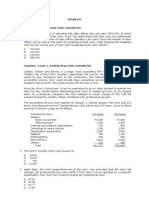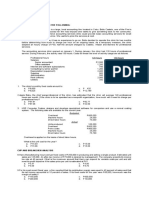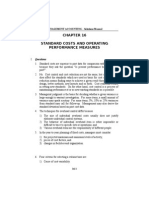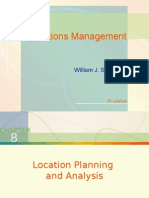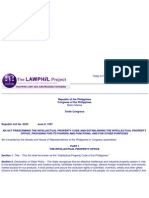Chapter 20 - Answer
Uploaded by
AgentSkySkyChapter 20 - Answer
Uploaded by
AgentSkySkyMANAGEMENT ACCOUNTING - Solutions Manual
CHAPTER 20
CAPITAL BUDGETING DECISIONS
I.
Questions
1. A capital investment involves a current commitment of funds with the
expectation of generating a satisfactory return on these funds over a
relatively extended period of time in the future.
2. Cost of capital is the weighted minimum desired average rate that a
company must pay for long-term capital while discounted rate of return is
the maximum rate of interest that could be paid for the capital employed
over the life of an investment without loss on the project.
3. The basic principles in capital budgeting are:
1. Capital investment models are focused on the future cash inflows and
outflows - rather than on net income.
2. Investment proposals should be evaluated according to their
differential effects on the companys cash flows as a whole.
3. Financing costs associated with the project are excluded in the
analysis of incremental cash flows in order to avoid the doublecounting of the cost of money.
4. The concept of the time value of money recognizes that a peso of
present return is worth more than a peso of future return.
5. Choose the investments that will maximize the total net present value
of the projects subject to the capital availability constraint.
4. The major classifications as to purpose are:
1. Replacement projects
- those involving replacements of worn-out assets to avoid
disruption of normal operations, or to improve efficiency.
2. Product or process improvement
- projects that aim to produce additional revenue or to realize cost
savings.
3. Expansion
- projects that enhance long-term returns due to increased profitable
volume.
5. Greater amounts of capital may be used in projects whose combined
returns will exceed any alternate combination of total investment.
20-1
Chapter 20 Capital Budgeting Decisions
6. No. This implies that any equity funds are cost free and this is a
dangerous position because it ignores the opportunity cost or alternative
earnings that could be had from the fund.
7. Yes, if there are alternative earnings foregone by stockholders.
8. Capital budgeting screening decisions concern whether a proposed
investment project passes a preset hurdle, such as a 15% rate of return.
Capital budgeting preference decisions are concerned with choosing from
among two or more alternative investment projects, each of which has
passed the hurdle.
9. The time value of money refers to the fact that a peso received today is
more valuable than a peso received in the future. A peso received today
can be invested to yield more than a peso in the future.
10. Discounting is the process of computing the present value of a future cash
flow. Discounting gives recognition to the time value of money and makes
it possible to meaningfully add together cash flows that occur at different
times.
11. Accounting net income is based on accruals rather than on cash flows.
Both the net present value and internal rate of return methods focus on
cash flows.
12. One simplifying assumption is that all cash flows occur at the end of a
period. Another is that all cash flows generated by an investment project
are immediately reinvested at a rate of return equal to the discount rate.
13. No. The cost of capital is not simply the interest paid on long-term debt.
The cost of capital is a weighted average of the individual costs of all
sources of financing, both debt and equity.
14. The internal rate of return is the rate of return on an investment project
over its life. It is computed by finding that discount rate that results in a
zero net present value for the project.
15. The project profitability index is computed by dividing the net present
value of the cash flows from an investment project by the investment
required. The index measures the profit (in terms of net present value)
provided by each peso of investment in a project. The higher the project
profitability index, the more desirable is the investment project.
16. Neither the payback method nor the simple rate of return method
considers the time value of money. Under both methods, a peso received in
the future is weighed the same as a peso received today. Furthermore, the
20-2
Capital Budgeting Decisions Chapter 20
payback method ignores all cash flows that occur after the initial
investment has been recovered.
II. Matching Type
1.
2.
3.
4.
5.
A
C
F
B
I
6.
7.
8.
9.
10.
H
D
G
J
E
III. Exercises
Exercise 1 (Simple Rate of Return Method)
The annual incremental net operating income is determined by comparing the
operating cost of the old machine to the operating cost of the new machine and
the depreciation that would be taken on the new machine:
Operating cost of old machine......................................................
Less operating cost of new machine.............................................
Less annual depreciation on the new machine (P80,000
10 years)..................................................................................
Annual incremental net operating income.....................................
P33,000
10,000
Cost of the new machine..............................................................
Less scrap value of old machine...................................................
Initial investment..........................................................................
P80,000
5,000
P75,000
Simple rate
of return
8,000
P15,000
Annual incremental net operating income
Initial investment
P15,000
=
= 20%
P75,000
Exercise 2 (Basic Present Value Concepts)
1. a. P400,000 0.794 = P317,600.
b. P400,000 0.712 = P284,800.
2. a. P5,000 4.355 = P21,775.
b. P5,000 3.685 = P18,425.
3. The factor for 10% for 20 years is 8.514. Thus, the present value of
20-3
Chapter 20 Capital Budgeting Decisions
Toms winnings would be:
P50,000 8.514 = P425,700.
Whether or not Tom really won a million pesos depends on your point of
view. She will receive a million pesos over the next 20 years; however, in
terms of its value right now she won much less than a million pesos as
shown by the present value computation above.
Exercise 3 (After-Tax Costs)
a.
Management consulting fee..............................
Multiply by 1 0.30........................................
After-tax cost...................................................
P100,000
0.70
P70,000
b.
Increased revenues...........................................
Multiply by 1 0.30........................................
After-tax cash flow (benefit)............................
P40,000
0.70
P28,000
c.
The depreciation deduction is P210,000 7 years = P30,000 per year,
which has the effect of reducing taxes by 30% of that amount, or P9,000
per year.
Exercise 4 (Basic Net Present Value Analysis)
Amount of
12%
Present Value
Year(s)
Cash Flows Factor of Cash Flows
Purchase of the stock.....................
Now
P(18,000)
1.000 P(18,000)
Annual dividends*.........................
1-4
P720
3.037
2,187
Sale of the stock............................4
P22,500
0.636
14,310
Net present value...........................
P( 1,503)
*900 shares P0.80 per share per year = P720 per year.
No, Ms. Cruz did not earn a 12% return on the share. The negative net present
value indicates that the rate of return on the investment is less than the
discount rate of 12%.
Exercise 5 (Internal Rate of Return and Net Present Value)
1.
Factor of the internal
=
rate of return
=
Required investment
Annual cash inflow
P136,700
P25,000
20-4
5.468
Capital Budgeting Decisions Chapter 20
A factor of 5.468 represents an internal rate of return of 16%.
2.
Item
Year(s)
Initial investment...........................
Now
Net annual cash inflows................
1-14
Net present value...........................
Amount of
16%
Present Value
Cash Flows Factor of Cash Flows
P(136,700) 1.000
P(136,700)
P25,000
5.468
136,700
P
0
The reason for the zero net present value is that 16% (the discount rate)
represents the machines internal rate of return. The internal rate of return is
the rate that causes the present value of a projects cash inflows to just equal
the present value of the investment required.
3.
Factor of the internal
=
rate of return
Required investment
Annual cash inflow
P136,700
The 6.835 factor is closest to 6.982,
the factor for the 11% rate of return.
= the
6.835is 11%.
P20,000
Thus, to the nearest whole percent,
internal rate =of return
Exercise 6 (Basic Net Present Value and Internal Rate of Return Analysis)
1.
Item
Year(s)
Initial investment.....................
Now
Annual cash inflows................1-4
Net present value....................
Amount of
Cash Flows
P(40,350)
P15,000
15% Present Value of
Factor
Cash Flows
1.000
P(40,350)
2.855
42,825
P 2,475
Yes, this is an acceptable investment. Its net present value is positive, which
indicates that its rate of return exceeds the minimum 15% rate of return
required by the company.
2.
Factor of the internal
=
rate of return
=
Investment required
Net annual cash inflow
P111,500
P20,000
20-5
5.575
Chapter 20 Capital Budgeting Decisions
A factor of 5.575 represents an internal rate of return of 16%.
3.
Factor of the internal
=
rate of return
Investment required
Net annual cash inflow
P14,125
A factor of 5.650 represents
internal rate =of 5.650
return of 12%. The
= an P2,500
company did not make a wise investment because the return promised by
the machine is less than the required rate of return.
20-6
Capital Budgeting Decisions Chapter 20
IV. Problems
Problem 1 (Equipment Replacement Sensitivity Analysis)
Requirement 1
Total Present Value
A.
B.
New Situation:
Recurring cash operating costs (P26,500 x 2.69)
Cost of new equipment
Disposal value of old equipment now
Present value of net cash outflows
Present Situation:
Recurring cash operating costs (P45,000 x 2.69)
Disposal value of old equipment four years hence
(P2,600 x 0.516)
Present value of net cash inflows
Difference in favor of replacement
P 71,285
44,000
(5,000)
P110,285
P121,050
(1,342)
P119,708
P 9,423
Requirement 2
Payback period for the new equipment
P44,000 P5,000
P18,500
2.1 years
Requirement 3
Let X = annual cash savings
Let O = net present value
X (2.69) + P5,000 - P44,000 - P1,342 = O
2.69X = P40,342
X = P14,997
If the annual cash savings decrease from P18,850 to P14,997 or by P3,503,
the point of indifference will be reached.
Another alternative way to get the same answer would be to divide the net
present value of P9,423 by 2.690.
Problem 2
Annual cash expenses of the manual bookkeeping
20-7
Chapter 20 Capital Budgeting Decisions
machine system, P9,800 x 12
Annual cash expenses of computerized data processing
Annual cash savings before taxes
Year 1
P64,000
20,000
P44,000
22,000
P42,000
Year 2
P64,000
16,000
P48,000
24,000
P40,000
Year 3
P64,000
12,800
P51,200
25,600
P38,400
After Tax
Cash Inflows
P42,000
40,000
38,400
20,000
15,600*
PV Factor
x 0.909
x 0.826
x 0.750
x 0.750
x 0.750
PV
P 38,178
33,040
28,800
15,000
11,700
P126,718
100,000
P 26,718
Annual cash savings (a)
Depreciation
Inflow before tax
Income tax (50%) (b)
Cash inflow after tax (a - b)
Year 1
Year 2
Year 3
Year 3 Salvage
Year 3 Tax loss
Investment (I)
Net present value (NPV)
_________________
*
P117,600
53,600
P 64,000
The P15,600 tax benefit of the loss on the disposal of the computer at the end of
year 3 is computed as follows:
Estimated salvage value
Estimated book value:
Historical cost
Accumulated depreciation
Estimated loss
Tax rate
Tax effect of estimated loss
P 20,000
P100,000
48,800
51,200
P(31,200)
50%
P(15,600)
Since the net present value is positive, the computer should be purchased
replacing the manual bookkeeping system.
Problem 3
Requirement 1
(a) Purchase price of new equipment
Disposal of existing equipment:
20-8
P(300,000)
Capital Budgeting Decisions Chapter 20
Selling price
Book value
Loss on disposal
Tax rate
Tax benefit of loss on disposal
Required investment (I)
0
60,000
P60,000
0.4
(b) Increased cash flows resulting from
change in contribution margin:
Using new equipment [18,000 (P20 - P7)] *
Using existing equipment [11,000 (P20 - P9)]
Increased cash flows
Less: Taxes (0.40 x P113,000)
Increased cash flows after taxes
Depreciation tax shield:
Depreciation on new equipment
(P300,000 5)
P60,000
Depreciation on existing equipment
(P60,000 5)
12,000
Increased depreciation charge P48,000
Tax rate
0.40
Depreciation tax shield
Recurring annual cash flows
_________________
*
24,000
P(276,000)
P234,000
121,000
113,000
45,200
P 67,800
19,200
P 87,000
The new equipment is capable of producing 20,000 units, but ETC Products
can sell only 18,000 units annually.
The sales manager made several errors in his calculations of required
investment and annual cash flows. The errors are as follows:
Required investment:
- The cost of the market research study (P44,000) is a sunk cost because it
was incurred last year and will not change regardless of whether the
investment is made or not.
- The loss on the disposal of the existing equipment does not result in an
actual cash cost as shown by the sales manager. The loss on disposal
results in a reduction of taxes, which reduces the cost of the new
equipment.
Annual cash flows:
- The sales manager considered only the depreciation on the new equipment
rather than just the additional depreciation which would result from the
acquisition of the new equipment.
- The sales manager also failed to consider that the depreciation is a noncash
expenditure which provides a tax shield.
20-9
Chapter 20 Capital Budgeting Decisions
-
The sales managers use of the discount rate (i.e., cost of capital) was
incorrect. The discount rate should be used to reduce the value of future
cash flows to their current equivalent at time period zero.
Requirement 2
Present value of future cash flows (P87,000 x 3.36)
Required investment (I)
Net present value
P292,320
276,000
P 16,320
Problem 4
Requirement 1: P(507,000)
Requirement 2: P(466,200)
Requirement 3: P(23,400)
Problem 5
1. The net annual cost savings is computed as follows:
Reduction in labor costs........................................................................
P240,000
Reduction in material costs....................................................................96,000
Total cost reductions..............................................................................
336,000
Less increased maintenance costs (P4,250 12)...................................51,000
Net annual cost savings.........................................................................
P285,000
2. Using this cost savings figure, and other data provided in the text, the net
present value analysis is:
Year(s)
Cost of the machine.....................................
Now
Installation and software..............................
Now
Salvage of the old machine..........................
Now
Annual cost savings.....................................
1-10
Overhaul required........................................
6
Salvage of the new machine........................
10
Net present value.........................................
20-10
Amount of
18%
Cash Flows Factor
P(900,000) 1.000
P(650,000) 1.000
P70,000
1.000
P285,000
4.494
P(90,000) 0.370
P210,000
0.191
Present Value
of Cash
Flows
P (900,000)
(650,000)
70,000
1,280,790
(33,300)
40,110
P (192,400)
Capital Budgeting Decisions Chapter 20
No, the etching machine should not be purchased. It has a negative net
present value at an 18% discount rate.
3. The intangible benefits would have to be worth at least P42,813 per year
as shown below:
Required increase in net present value
P192,400
=
Factor for 10 years
4.494 = P42,813
Thus, the new etching machine should be purchased if management
believes that the intangible benefits are worth at least P42,813 per year to
the company.
Problem 6
(2)
Tax
Effect
(1)
Items and Computations
Year(s) Amount
Investment in new trucks..........................................
Now P(450,000)
Salvage from sale of the old trucks..........................
Now
P30,000 1 0.30
Net annual cash receipts..........................................
1-8
P108,000 1 0.30
Depreciation deductions*..........................................
1-8
P56,250
0.30
Overhaul of motors...................................................
5
P(45,000) 1 0.30
Salvage from the new trucks....................................
8
P20,000 1 0.30
Net present value.....................................................
(1) (2)
After-Tax
Cash
Flows
P(450,000)
P21,000
P75,600
P16,875
P(31,500)
P14,000
12%
Factor
1.000
1.000
4.968
4.968
0.567
0.404
Present
Value of
Cash
Flows
P(450,000)
21,000
375,581
83,835
(17,861)
5,656
P 18,211
* P450,000 8 years = P56,250 per year
Since the project has a positive net present value, the contract should be
accepted.
Problem 7
1.
Factor of the internal
=
rate of return
Required investment
Annual cash inflow
P142,950
P37,500
3.812
A factor of 3.812 equals an 18% rate of return.
Verification of the 18% rate of return:
Item
Amount of
Present Value
Cash
18%
of Cash
Year(s)
Flows
Factor
Flows
20-11
Chapter 20 Capital Budgeting Decisions
Investment in equipment..........................
Now P(142,950) 1.000
Annual cash inflows................................
1-7
P37,500 3.812
Net present value....................................
2.
Factor of the internal
=
rate of return
P(142,950)
142,950
P
0
Required investment
Annual cash inflow
We know that the investment is P142,950, and we can determine the factor for
an internal rate of return of 14% by looking at the PV table along the 7-period
line. This factor is 4.288. Using these figures in the formula, we get:
P142,950
Annual cash inflow
4.288
Therefore, the annual cash inflow would have to be:
P142,950 4.288 = P33,337.
3. a. 5-year life for the equipment:
The factor for the internal rate of return would still be 3.812 [as computed
in (1) above]. Reading along the 5-period line of the PV table, a factor of
3.812 is closest to 3.791, the factor for 10%. Thus, to the nearest whole
percent, the internal rate of return is 10%.
b. 9-year life for the equipment:
The factor of the internal rate of return would again be 3.812. From the
PV table, reading along the 9-period line, a factor of 3.812 is closest to
3.786, the factor for 22%. Thus, to the nearest whole percent, the internal
rate of return is 22%.
The 10% return in part (a) is less than the 14% minimum return that Dr.
Blue wants to earn on the project. Of equal or even greater importance, the
following diagram should be pointed out to Dr. Blue:
20-12
Capital Budgeting Decisions Chapter 20
As this illustration shows, a decrease in years has a much greater impact
on the rate of return than an increase in years. This is because of the time
value of money; added cash inflows far into the future do little to enhance
the rate of return, but loss of cash inflows in the near term can do much to
reduce it. Therefore, Dr. Blue should be very concerned about any
potential decrease in the life of the equipment, while at the same time
realizing that any increase in the life of the equipment will do little to
enhance her rate of return.
4. a. The expected annual cash inflow would be:
P37,500 x 120% = P45,000
P142,950
P45,000
3.177
Reading along the 7-period line of the PV table, a factor of 3.177 is closest
to 3.161, the factor for 25%, and is between that factor and the factor for
24%. Thus, to the nearest whole percent, the internal rate of return is 25%.
b. The expected annual cash inflow would be:
P37,500 x 80% = P30,000
P142,950
P30,000
4.765
Reading along the 7-period line of the PV table, a factor of 4.765 is closest
to 4.712, the factor for 11%. Thus, to the nearest whole percent, the
internal rate of return is 11%.
Unlike changes in time, increases and decreases in cash flows at a given
point in time have basically the same impact on the rate of return, as
shown below:
20-13
Chapter 20 Capital Budgeting Decisions
5. Since the cash flows are not even over the five-year period (there is an extra
P61,375 cash inflow from sale of the equipment at the end of the fifth year),
some other method must be used to compute the internal rate of return. Using
trial-and-error or more sophisticated methods, it turns out that the actual
internal rate of return will be 12%:
Amount of
Cash
12%
Flows
Factor
P(142,950) 1.000
P30,000
3.605
P61,375
0.567
Item
Year(s)
Investment in the equipment............................
Now
Annual cash inflow...........................................
1-5
Sale of the equipment.......................................
5
Net present value..............................................
Present
Value of
Cash Flows
P(142,950)
108,150
34,800
P
0
Problem 8
1. The income statement would be:
Sales revenue.............................................................
Less commissions (40% P200,000)........................
Contribution margin...................................................
Less fixed expenses:
Maintenance........................................................... P50,000
Insurance................................................................ 10,000
Depreciation*......................................................... 36,000
Total fixed expenses...................................................
Net operating income.................................................
P200,000
80,000
120,000
96,000
P24,000
*P180,000 5 years = P36,000 per year
2. The initial investment in the simple rate of return calculations is net of the
salvage value of the old equipment as shown below:
Simple
rate of return
Annual incremental net operating income
Initial investment
P24,000
P180,000 P30,000
20-14
P24,000
P150,000
16%
Capital Budgeting Decisions Chapter 20
Yes, the games would be purchased. The return exceeds the 14% threshold set
by the company.
3. The payback period would be:
Payback
period
Investment required
Net annual cash inflow
P180,000 P30,000
P150,000
=
= 2.5 years
P60,000*
P60,000
*Net annual cash inflow = Net operating income + Depreciation
= P24,000 + P36,000 = P60,000.
=
Yes, the games would be purchased. The payback period is less than the 3
years.
IV. Multiple Choice Questions
1.
2.
3.
4.
5.
6.
7.
8.
9.
10.
D
C
B
B
A
C
D
B
B
A
11.
12.
13.
14.
15.
16.
17.
18.
19.
20.
D
D
D
C
C
D
D
B
A
A
21.
22.
23.
24.
25.
26.
27.
28.
29.
30.
20-15
C
B
C
D
C
C
D
B
D
A
31.
32.
33.
34.
35.
36.
37.
38.
39.
40.
D
C
C
D
D
B
B
B
D
B
You might also like
- Reviewer in Intacc 3 Intermediate Accounting 3 - CompressNo ratings yetReviewer in Intacc 3 Intermediate Accounting 3 - Compress13 pages
- Psa 610 Using The Work of Internal Auditors: RequirementsNo ratings yetPsa 610 Using The Work of Internal Auditors: Requirements2 pages
- Drill 2 Working Capital Current Liabilities ANSWERS PDFNo ratings yetDrill 2 Working Capital Current Liabilities ANSWERS PDF7 pages
- Solution:: Answer: The Cost of The Preferred Stock Is 12.24%No ratings yetSolution:: Answer: The Cost of The Preferred Stock Is 12.24%1 page
- Responsibility Acctg, Transfer Pricing & GP AnalysisNo ratings yetResponsibility Acctg, Transfer Pricing & GP Analysis21 pages
- Grove Isle Savings & Loan Is Paying 6% Interest Compounded Monthly. How Much Will $100 Deposited at The End of Each Month Be Worth After 2 Years?No ratings yetGrove Isle Savings & Loan Is Paying 6% Interest Compounded Monthly. How Much Will $100 Deposited at The End of Each Month Be Worth After 2 Years?8 pages
- Capital Budgeting Decisions and Cost of Capital PDF0% (1)Capital Budgeting Decisions and Cost of Capital PDF4 pages
- 07.2 UPDATED Capital Investment DecisionsNo ratings yet07.2 UPDATED Capital Investment Decisions6 pages
- (Mas) 04 - Standard Costing and Variance Analysis0% (1)(Mas) 04 - Standard Costing and Variance Analysis7 pages
- MAS Integration Exercise 1 Cost BehaviorNo ratings yetMAS Integration Exercise 1 Cost Behavior4 pages
- Part I. Multiple Choice Questions: Select The Best Statement or Words That Corresponds To The QuestionNo ratings yetPart I. Multiple Choice Questions: Select The Best Statement or Words That Corresponds To The Question8 pages
- AT.3502 - Introduction To Audit and Other Assurance ServicesNo ratings yetAT.3502 - Introduction To Audit and Other Assurance Services5 pages
- Unit II CFS Subsequent To Date of AcquisitionNo ratings yetUnit II CFS Subsequent To Date of Acquisition10 pages
- Practice Problems - Capital Budgeting PDFNo ratings yetPractice Problems - Capital Budgeting PDF2 pages
- Financial Management 2: Capital Budgeting Problems and Exercises PART 1 Problems Problem 1No ratings yetFinancial Management 2: Capital Budgeting Problems and Exercises PART 1 Problems Problem 17 pages
- The Common Assumption in Capital Budgeting AnalysiNo ratings yetThe Common Assumption in Capital Budgeting Analysi5 pages
- BAFINMAX Handout Introduction To Working Capital ManagementNo ratings yetBAFINMAX Handout Introduction To Working Capital Management2 pages
- David SM Chapter 2 PPT by Fred R David Stategic Management Concepts and Cases 13th Edition0% (2)David SM Chapter 2 PPT by Fred R David Stategic Management Concepts and Cases 13th Edition38 pages
- Performance-Related and Skill-Based Pay: An Introduction: ACT/EMP/17No ratings yetPerformance-Related and Skill-Based Pay: An Introduction: ACT/EMP/1744 pages
- Method Statement For Application of GRP Lining Inside Water Tank100% (1)Method Statement For Application of GRP Lining Inside Water Tank5 pages
- Push-In Thermocouples With Terminal Head Form A: Technical DataNo ratings yetPush-In Thermocouples With Terminal Head Form A: Technical Data4 pages
- Ion Exchange Demineralizers: Big Problems, Small SolutionsNo ratings yetIon Exchange Demineralizers: Big Problems, Small Solutions10 pages
- Manual de Utilizare Masina de Spalat IndesitNo ratings yetManual de Utilizare Masina de Spalat Indesit84 pages
- RA 8293-Intellectual Property Code of The PhilippinesNo ratings yetRA 8293-Intellectual Property Code of The Philippines57 pages
- Reviewer in Intacc 3 Intermediate Accounting 3 - CompressReviewer in Intacc 3 Intermediate Accounting 3 - Compress
- Psa 610 Using The Work of Internal Auditors: RequirementsPsa 610 Using The Work of Internal Auditors: Requirements
- Drill 2 Working Capital Current Liabilities ANSWERS PDFDrill 2 Working Capital Current Liabilities ANSWERS PDF
- Solution:: Answer: The Cost of The Preferred Stock Is 12.24%Solution:: Answer: The Cost of The Preferred Stock Is 12.24%
- Responsibility Acctg, Transfer Pricing & GP AnalysisResponsibility Acctg, Transfer Pricing & GP Analysis
- Grove Isle Savings & Loan Is Paying 6% Interest Compounded Monthly. How Much Will $100 Deposited at The End of Each Month Be Worth After 2 Years?Grove Isle Savings & Loan Is Paying 6% Interest Compounded Monthly. How Much Will $100 Deposited at The End of Each Month Be Worth After 2 Years?
- Capital Budgeting Decisions and Cost of Capital PDFCapital Budgeting Decisions and Cost of Capital PDF
- Part I. Multiple Choice Questions: Select The Best Statement or Words That Corresponds To The QuestionPart I. Multiple Choice Questions: Select The Best Statement or Words That Corresponds To The Question
- AT.3502 - Introduction To Audit and Other Assurance ServicesAT.3502 - Introduction To Audit and Other Assurance Services
- Financial Management 2: Capital Budgeting Problems and Exercises PART 1 Problems Problem 1Financial Management 2: Capital Budgeting Problems and Exercises PART 1 Problems Problem 1
- The Common Assumption in Capital Budgeting AnalysiThe Common Assumption in Capital Budgeting Analysi
- BAFINMAX Handout Introduction To Working Capital ManagementBAFINMAX Handout Introduction To Working Capital Management
- David SM Chapter 2 PPT by Fred R David Stategic Management Concepts and Cases 13th EditionDavid SM Chapter 2 PPT by Fred R David Stategic Management Concepts and Cases 13th Edition
- Performance-Related and Skill-Based Pay: An Introduction: ACT/EMP/17Performance-Related and Skill-Based Pay: An Introduction: ACT/EMP/17
- Method Statement For Application of GRP Lining Inside Water TankMethod Statement For Application of GRP Lining Inside Water Tank
- Push-In Thermocouples With Terminal Head Form A: Technical DataPush-In Thermocouples With Terminal Head Form A: Technical Data
- Ion Exchange Demineralizers: Big Problems, Small SolutionsIon Exchange Demineralizers: Big Problems, Small Solutions
- RA 8293-Intellectual Property Code of The PhilippinesRA 8293-Intellectual Property Code of The Philippines




















